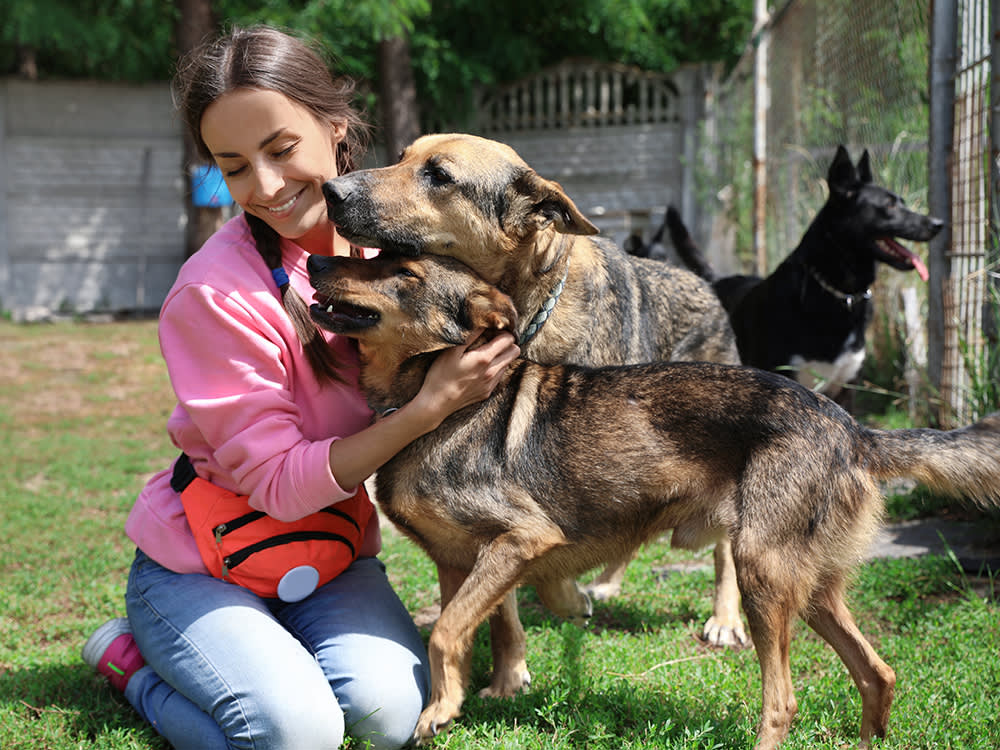How to Start an Animal Rescue
If you are ready to take the plunge and start your own dog or cat rescue, this guide will help you set up a successful non-profit.

share article

Your pet wants you to read our newsletter. (Then give them a treat.)
It often begins with a whisper: “Wouldn’t it be great if we had our own rescue?” Volunteers at shelters across the country rejoice when dogs get adopted and, on the other end of the spectrum, experience utter sadness when dogs are euthanized for no apparent reason. Most volunteers, especially those at high-kill shelters, have had the thought, there has to be a better way. And volunteer-run rescue groups all over the country are trying to figure it out. If you’ve decided it’s worth a try and are ready to take the plunge, we’ve got you covered with everything you need to know about starting your own animal rescue.
Tips on Starting an Animal Rescue
Seek advice from other animal rescuers and shelters.
Pick your rescue niche and stick to your choice.
Develop a business plan.
Recruit a group of devoted and highly experienced volunteers, including local merchants and business supporters.
Work with the veterinary community to obtain free or reduced-rate procedures.
Obtain 501(c)(3) nonprofit status, which is invaluable for fundraising.
Publish a newsletter to promote supporters and adoption success stories.
Make spay/neuter a top priority.
Finding Your Inspiration
The idea of starting my own animal rescue group had been with me for years before I finally embarked on this path in 2003. You might say it was destiny, given my love of animals and relative unsuitability for the other pursuits I’d attempted over the years.
In the beginning, I volunteered with the Oregon Humane Societyopens in a new tab. There, I met Sharon Harmon, the genius executive director who turned that organization into a juggernaut of humane societies. So when I began to contemplate starting my own nonprofit rescue group, I could think of no one better than Sharon to consult about my idea.
She gave me the two pieces of advice that shaped my entire enterprise and that I never strayed from. First, select a specific niche rather than trying to save every animal in the world. Second, stay small and stick to the stated mission.
Establish Your Animal Rescue Niche
You want to save animalsopens in a new tab. The good news: so do the shelters and rescues in your area. The bad news: so do the shelters and rescues in your area. Of course, it’s not really bad news, but it does make it harder for the new kid on the block (that’s you) to stand out. So you have to ask yourself what you’re going to do that’s different.
While I initially included both dogs and cats in my rescue effort, I eventually chose to concentrate on pregnant dogs and their offspring. I saw a need there because many shelters didn’t have special facilities for neonates, nor did they have legions of foster volunteers who could be counted upon to care for these animals in their homes.
In a best-case scenario at conventional shelters, if the pregnant dog herself was not euthanized, she was spayed, thus aborting the puppies. I get the rationale. There are already too many unwanted puppies, so why bring more into the world? I was also determined to take in pregnant dogs and/or their litters only from shelters rather than individuals. (That’s worked out pretty well, although I did take them from individuals once in a while when no other recourse was available.) So, this became my niche.
Following Sharon’s advice is what kept me from burning out after the first couple of years. I freely admit that I can’t save them all. But I like to think that I do my part and that, together with all the other dog rescues and shelters, we can save them all.
When you first start out, you will have a lot of ideas about how your rescue is going to function. Putting ideas in writing is a great way to get started, but once you get into the day-to-day, you’ll probably find that some of them don’t work, aren’t relevant, or just aren’t what you want to do anymore.
Getting Volunteers to Sign Up
It will be impossible to get your rescue off the ground without good, highly committed, like-minded people. This includes everyone from board members to volunteers who put up flyers around town. But nowhere is it more essential than with those who foster. Unless you have a facility available to you, you’re going to have to rely on fosters to provide homes for your dogs.
I recruited a very special group of foster families, people who were devoted to caring for the moms and pups for extended periods of time. It takes a certain kind of person to open their home to an animal for months on end; transport her back and forth to vet appointments; and put up with a houseful of yipping, pooping puppies. Not to mention foot the bill for most of the expenses along the way and deal with foster dogs that bite, destroy furniture, chew up designer handbags, and do all manner of damage out of fear and confusion.
Bottom line: Take your time finding good fosters. Put together a thorough foster application, talk to them at length on the phone and visit them in their home. Trust your gut about how committed they are.
Check Into Certifications and Insurance
Then there’s taking care of the boring stuff, like liability insurance and nonprofit certification, should you go that route. Involve people who are experienced in different areas. People come to foster care from all sorts of backgrounds. Some are like me and want to save an animal. Others are empty-nesters who just want someone to cuddle.
Regardless of their motives, the folks who became foster parents should have some advanced backgrounds in animal care, or you should be prepared to provide guidance. So, make sure you have access to a trainer or behaviorist. They’ll be crucial to help work with dogs, but more importantly, they’ll be able to assist in providing guidance to the fosters working with the dogs on a daily basis.
You should also find someone who has expertise in fundraising, another who’s good at publicity, and someone who can evaluate and possibly train your dogsopens in a new tab. Your group might be served well with professional training certifications to help guide you with the running of the organization. There are certificates in animal shelter management and nonprofit management. And it never hurts to have an attorney on call.
Getting Vets to Sign On
In those early days, I was lucky to find veterinarians who were willing to provide pro bono spay/neuteropens in a new tab services for the mom and puppies (you may find others will provide low-cost services for rescues). This allowed me to ensure 100 percent compliance with my rule that all animals had to be altered prior to adoption. Giving these dogs a chance at life came with the strict vow that this would be the end of the line. No additional puppies would be born to my animals. Period.
My vets were heartily in favor of this rule and gave selflessly to the cause for several years. I found these big-hearted vets by sending out a simple postcard to all the local animal hospitals, describing my organization and asking for their help. I can’t thank those vets enough who responded to my call.
Figuring Out Fundraising
How do you put logic ahead of compassion when it comes to saving lives? I can only tell you that it’s important to keep your heart in check or you’ll quickly find yourselves overwhelmed, both functionally and financially.
I learned that the way most shelters made their money in adoption fees was by rapid turnover. That was clearly not possible when dealing with my select group. As mentioned, it takes several months to birth, wean, raise and socialize puppies, and then have them altered prior to adoption.
As a small dog rescue group, we had no endowment, and no one was making large donations. We had to come up with fundraisers to fill that gap. A lot of local merchants were only too glad to sponsor us. Pet shops gave us food and merchandise. We did dog washes, held yard sales, provided boarding and walking, and did everything else that was legal and would provide money for the cause.
It also helped that 100 percent of our donations went to the animals. We had no administrative costs and no paid staff. Beyond in-kind donations, expenses such as pet food, equipment, and postage were all strictly out-of-pocket.
Promotion, Outreach, and Administrative Work
Something you might not be prepared for is that the majority of the time you devote to your rescue will probably be spent running the organization rather than working with animals. These tasks include: all the written communication (Facebook posts, newsletters, brochures, flyers, ads, promotions, signs, appeal letters); licenses, insurance policies and permits; creating a website; arranging adoption events; running board meetings; fundraising; designing and ordering t-shirts and car magnets. And the list goes on.
We issued a monthly newsletter that touted our recent adoption stories, gave general pet advice and information, and featured a wish list of things we needed, such as litter, paper towels, and so forth. We also put out a plea for donations in each issue. Since the newsletter went out to a specialized audience of prior adopters, operators of pet businesses and other stakeholders, the resulting donations were pretty spectacular. Animal people have a sincere desire to be of help and will help monetarily even when they are unable to provide hands-on assistance. In addition, we endorsed the vets who worked with us and encouraged people to use them for their own pets.
How Do You Know to Take the Plunge?
People always ask me how I gained the confidence to start this thing and run it day in and day out. Part of the answer is simply age. I have enough life experience to say, What the hell, I want to do this. I’ve been through the best and worst parts of a corporate career. I’ve had my heart broken enough times to have developed a fairly thick skin. In other words, I am a stubborn old broad who wasn’t going to let anything stand in my way.
Once I bought my first home at age 50, specifically for this purpose, I knew the rest of the plan would fall into place. I started hitting garage sales for dog crates and other equipment. I read up on all phases of animal husbandry. I consulted experts for advice (such as Sharon Harmon at Oregon Humane). I networked the heck out of the animal community to find information and resources. I guess it just never occurred to people to question me. They believed in me simply because they could tell I wasn’t going to take no for an answer.
It was an ongoing process. Asking for money has never been my strong suit but, even so, people were very generous and found ways to help when needed. It was just a matter of time until I’d come up with the money and know-how to further my project. (If only all the world were made up of animal people.) Admittedly, a few of my neighbors and I didn’t always see eye-to-eye about how I choose to utilize my property, but most seemed to put up with me pretty admirably.
Rescue Groups Do Make a Difference
By 2018, we had been a solid, well-oiled machine for more than 15 years. But that year, for the first time, we had a summer without dogs. The reasons were many. First, other shelters were just as busy developing foster volunteers as I was. Increasingly, an incoming pregnant female could be placed in their own foster network and retained rather than transferring her out to Other Mothers. Second, at least here in Portland, people were getting hip to spay/neuter, and there were fewer unwanted litters out there in the community.
It was a good result of years of preaching to the masses about spay/neuter, and I couldn’t very well object to people listening. Of course, I missed the frequent pitter-patter of little feet, but, at the same time, I was happy to have been made largely obsolete. It meant that more dogs were being saved, which is why I started this enterprise to begin with.
This work has given me so much in the way of enrichment, taught me new skills, and allowed me to hobnob with some very special animals and people over the years, so I’m not about to hang it up yet. There are still animals out there who need rescuing, and I’m very good at what I do. Why stop now?
Linda Caradine
Linda Caradine founded Other Mothers, a Portland, Ore., animal rescue group devoted to pregnant dogs and their pups. In 2006 she received Oregon Humane Society’s Diamond Heart Hero award for her contribution to animal welfare.
Related articles
![A woman holding up a treat while shaking a dogs paw.]() opens in a new tab
opens in a new tabSo, You Want to Work with Animals
On the prowl for a new career path? A director at the Humane Society has some pro tips.
![anonymous woman pampering and taking care about a small ginger kitten]() opens in a new tab
opens in a new tab6 Ways to Help Local Shelters Without Committing to Full-Time Pet Parenthood
Adoption isn’t for everyone—here are other ways you can be there for animals in need.
![A hand holding a kitten with a cat tattooed at the hand.]() opens in a new tab
opens in a new tabHeads Up: It’s Officially “Kitten Season”
Hannah Shaw, aka Kitten Lady, on how you can care for orphaned kittens this spring.


